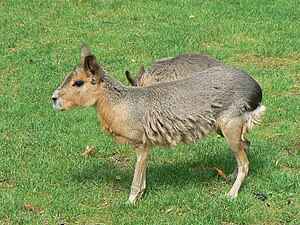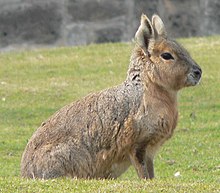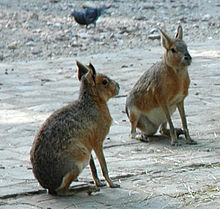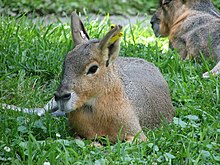Big pampas bunny
| Big pampas bunny | ||||||||||||
|---|---|---|---|---|---|---|---|---|---|---|---|---|

Big pampas bunny |
||||||||||||
| Systematics | ||||||||||||
|
||||||||||||
| Scientific name | ||||||||||||
| Dolichotis patagonum | ||||||||||||
| ( Zimmermann , 1780) |
The great pampas hare or the great mara ( Dolichotis patagonum ) is a species of rodent from the guinea pig family (Caviidae) living in Argentina . Together with the small pampas hares , it forms the genus of pampas hares .
features
General
The great pampas rabbit is the largest representative of the guinea pigs after the capybara - the largest living rodent. It reaches a head body length of 61 to 81 centimeters (on average 71 centimeters), the tail is a stub no more than 5 centimeters in length, it is flattened and almost hairless. Males reach an average weight of 7.7 kilograms, females are slightly heavier at 8.3 kilograms - the maximum weight is 16 kilograms.
Their fur is gray-brown (aguti) on the upper side, the belly is white. The back of the thighs are also white, there is also a noticeable black stripe above. The flanks and chin, sometimes the sides of the head, are orange to rust colored. The fur of these animals is dense and short, but gives a bristle impression.
The build of the pampas hares is described as rabbit-like , which is mainly due to the long legs and the big ears. Except for these two characteristics, they are similar to guinea pigs. As with all members of this family, the front feet end in four and the rear feet in three toes. The hind feet have hoof-like claws, the front feet have sharp claws that are suitable for digging. The hind legs are longer than the front legs, whereby, as in many fast-moving animals, the stylopodium (upper arm or thigh) is shorter than the zygopodium (forearm or lower leg). With the development of long limbs as an adaptation to a way of life in grasslands and steppes, pampas rabbits are taking up the ecological niches that are elsewhere occupied by ungulates . This can be seen in a number of convergent developments, for example in the reduction of the collarbones .
Head and teeth
The large, narrow head is mainly characterized by the long, 9 to 10 centimeter long ears. This goes hand in hand with a good sense of hearing, which is important for perception in open habitats. The eyes are large and attached to the side of the head. The nose is blunt, the vibrissae are well developed. In the structure of the skull , the nasal bone is conspicuous, which is large and pointed towards the front, but not as far in front as the maxilla . The frontal bone is very broad and the tear bone very large.
The dental formula is as in all caviomorpha 1 / 1-0 / 0-1 / 1-3 / 3 = 20, that is, per half of the jaw, they have a pronounced than incisor tooth incisor , not canine , a premolar (Vorbackenzahn) and three molars (molars ). The incisor teeth, like those of almost all rodents, are rootless and grow back for a lifetime. As in all rodents, canine teeth are missing, and there is a gap between the incisors and molars called a diastema . As with all guinea pigs, the molars are rootless and permanently growing.
Internal anatomy
The digestive tract is similar to that of other guinea pigs. The stomach is built simply, they are rectal fermenters. This means that they can break down cellulose in their appendix (caecum) using symbiotic bacteria . The colon (colon) is modified for this purpose and often has complex folds. These adaptations go hand in hand with the caecotrophy , the repeated picking up of the excrement for better utilization of the food.
A special feature of the Pampas rabbit is that the anal gland is located between the anus and the base of the tail - in the other guinea pigs it is located in front of the anus.
distribution and habitat
Large pampas hares are endemic to Argentina . Their distribution area extends approximately from the 28th to the 50th parallel, that is from the provinces of Catamarca and Córdoba in the north to Santa Cruz in the south. Their habitat are open, deeper habitats. They mainly inhabit grass steppes ( Pampas and Monte ), but also light forests and dry regions (such as the Valdés peninsula ). They prefer areas with bushes or trees as privacy and cover.
Way of life
Activity times and movement
Large pampas hares are diurnal. They spend around half of the day (46%) eating, but can often be seen sunbathing. They do not dig their own burrows when they sleep (except to raise young ones), they sleep hidden in dense vegetation or take over burrows from other animals, such as viscachas .
Depending on their needs, they practice different types of locomotion, slow walking, rabbit-like hobbling or hopping with all four legs. They can reach speeds of up to 45 km / h over 1 kilometer. The resting positions are either sitting on the buttocks with the front legs stretched out or lying down with the front legs folded like a cat under the chest - both postures atypical for rodents. It corresponds more to the resting position of rabbits.
Social and territorial behavior
In terms of social behavior, pampas rabbits show the combination of monogamy and rearing boys together, which is unique among mammals . These animals live strictly monogamous, which means that the couples stay together for years and usually only change partners when one partner dies. The reason for this is likely to be primarily due to the extreme shortness of the conception readiness. The pair bond is primarily maintained by the male, it follows the female wherever it goes. The male also sprays the female with urine and the ground around the female with anal gland secretions and feces , this spraying serves to push back male rivals. But females also sometimes spray the male's face with urine, presumably to show him that he is not ready to conceive. Especially during pregnancy and suckling, the female has to eat far more than males; the males spend this time sitting next to the female and keeping watch - both from predators and rivals.
Several pairs together form loose associations that can contain up to 70 animals. The males establish a hierarchy among themselves, the behaviors used also include spraying with urine, as well as presenting the buttocks as well as chases and bites in the trunk.
Each couple lives in an exclusive area of around 10 hectares. However, the boundaries of the area are constantly shifting due to constant migration, and calculated over the year the area size is 33 to 200 (average 100) hectares. Over time, the territories of the individual pairs overlap strongly.
Large pampas rabbits communicate with squeaking noises, which are used to establish contact, and utter grunts when threatened. Raising hair and chattering teeth are also used for visual communication. As mentioned above, olfactory communication plays a crucial role.
Natural enemies and threats
Among the natural enemies of the Maras are predators such as pampas cat , Geoffroy's cats , pumas , Grisons and Kamp foxes , for young animals and birds of prey like can Magellanuhus and blue buzzards are dangerous. Of parasites is nematode Wellcomia dolichotis known specializing in Maras.
food
These animals are opportunistic herbivores that eat grass, herbs, but also bushes (for example mesquite bushes ). For better utilization of the food they practice the caecotrophy , the repeated consumption of the feces. The caecum , a soft, sticky form of feces, the material of which is fermented in the caecum with the help of special bacteria , is consumed again immediately after excretion. In this way, the animals can use the hard-to-digest, cellulose-containing food in the best possible way. The feces that arise after digestion are dry and are not taken up again.
In general, pampas rabbits are very efficient food users. They need less food per kilogram of body weight than sheep or cattle, for example .
Reproduction
Mating and pregnancy
Female pampas rabbits have an extremely short oestrus , they are only ready to conceive for half an hour every 3 to 4 months. That should also be the reason for the strict monogamy of these animals.
Mating occurs seasonally, with most births occurring between August and November, with the peak between late September and early October. During this time, spring before the summer drought prevails in their habitat. While the animals only have one litter a year in the wild, it can be three to four litters a year in human care. The gestation period is 91 to 110 (average 100) days. The litter size averages two young animals, but can also be one or three.
Rearing boys
Newborn large pampas rabbits weigh 480 to 730 grams, they flee the nest and can walk right after birth. Up to 29 couples set up a common camp for rearing boys, which is a complex of several earth structures and in which up to 33 young animals live. The female comes to the burrow once a day for around 1 hour to suckle her young; other animals are circling the camp meanwhile. During this storage period, a couple never moves further than 2.5 kilometers from the camp. Despite the joint construction, there is no cooperation between the mothers. Every female tries to nurse only her own young, which she recognizes by their smell and voice. Nevertheless, some young animals manage to drink from strange females again and again. It is controversial whether this will enable orphaned young animals to grow up. The mortality of the young animals is high, which is due not only to the predators but also to diseases and hypothermia. The larger the juvenile camp, the higher the chances of survival.
This first phase of the time in the camp lasts around 3 weeks. The young animals stay in or near the camp, they maintain close physical contact, which is important for warming, they cuddle up to each other and play. The second phase is in the 4th to 13th week of life. At this time the young follow their parents in search of food, but are still suckled. Final weaning occurs at 75 to 80 days, which is very long by rodent standards.
Sexual maturity occurs (at least in females) around 8 months. Life expectancy in the wild is probably not more than 10 years, in human care these animals can live up to 14 years.
Human and Big Pampashase
An important factor in the threat is food competition with introduced animals, especially hares , which were not originally native to southern South America, and the conversion of their habitat into pastures for cattle and farmland also poses a certain degree of threat. Hunting plays a minor role , sometimes they are persecuted for their flesh or to make blankets out of their fur. Large pampas have become rare in some areas, for example they have become extinct in the province of Buenos Aires . Overall, the species is not yet endangered, the IUCN has classified it as potentially endangered.
Large pampas hares are common in zoos and are easy to breed.
Systematics
The large pampashase forms together with the small pampashase the genus of the pampashase ( Dolichotis ), which form a separate subfamily, Dolichotinae, within the guinea pigs (Caviidae). This group has been known to have been fossilized since the late Miocene , fossil finds from the provinces of Buenos Aires and Córdoba.
There are two subspecies, D. p. centricola in the middle and D. p. patagonum in southern Argentina, the differences are mainly in the coat color.
literature
- Claudia M. Campos, Marcelo F. Tognelli, Ricardo A. Ojeda: Dolichotis patagonum. In: Mammalian Species. No. 652, 2001, pp. 1–5, online (PDF; 217.45 kB) ( Memento from March 25, 2016 in the Internet Archive ).
Web links
- Dolichotis patagonum in the endangered Red List species the IUCN 2006. Posted by: Baillie, 1996. Retrieved on 11 May, 2006.







